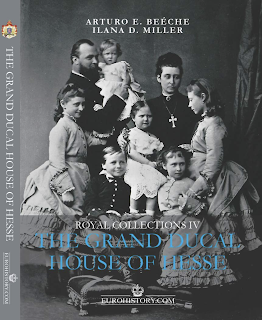To purchase:
“Royal Collections IV. The Grand Ducal House of Hesse” by Arturo E. Béeche and Ilana D Miller. (Eurohistory.com), 324 pages, illustrated throughout.
The Grand Ducal House of Hesse is among the most important of all the German dynasties, providing links to just about every other ruling family in Europe. There are particularly strong ties with Imperial Russia and the Royal family of Britain, which makes for an engrossing read.
The story begins in 1567 when the sons of Landgrave Philipp “the Magnificent” divided his vast lands among themselves. From this territorial division stem all the branches of the Hesse family. The Landgraviate of Hesse-Darmstadt became an independent Duchy that same year.
The early years are a succession of reshuffling of territories, as lands were traded, exchanged or inherited when branches of the family died out. Not until Ludwig IV (died 1626) was primogeniture established.
Darmstadt was also in the front line during various wars. The sons of the house were soldiers and patrons of the arts. Landgrave Ernest Ludwig built Wolfsgarten in the 1720s, which became beloved by later generations.
In 1806 Landgrave Ludwig X became Grand Duke Ludwig I, courtesy of Napoleon and the Confederation of the Rhine. At this time the Old Palace was built.
Schloss Heiligenberg came into the family in the time of Ludwig II. It later became the scene of many family gatherings between the Hesse and Romanov families. Ludwig’s wife Wilhelmine had a second family, believed to be fathered by August Senarclens de Grancy but officially recognised by the Grand Duke as his own. One of these children, Marie, married Alexander II of Russia; the other, Alexander, made a morganatic union with Countess Julie von Hauke and became the ancestor of the Battenberg family.
Ludwig II was succeeded by the childless Ludwig III and it was the latter’s nephew the future Ludwig IV who brought in the British connection when in 1862 he married Princess Alice, second daughter of Queen Victoria. Their daughter Victoria married Alexander and Julie’s son Prince Louis of Battenberg and became the mother of Princess Alice (wife of Prince Andrew of Greece), Queen Louise of Sweden, George the Marquess of Milford Haven and Earl Mountbatten of Burma. Princess Alice of Greece was the mother of the Duke of Edinburgh.
The family of Alice and Ludwig IV suffered tragedy after tragedy. Two daughters, Alix (wife of Nicholas II) and Ella (wife of Grand Duke Sergei Alexandrovich) met their deaths in 1918 at the hands of the Bolsheviks. Ernest Ludwig died just a month before his son George Donatus, his wife Cecile of Greece and their two sons were wiped out in an air crash in thick fog on their way to the wedding of George’s brother Ludwig and Margaret Geddes. Their third child died shortly afterwards from Meningitis. Despite all this Ludwig and Margaret (or Lu and Peg as they were known) devoted themselves to the welfare of the people of Darmstadt, becoming humanitarians and patrons of the arts. Unfortunately, their marriage remained childless and marked the end of the line. The royal turn-out for Peg’s funeral in 1997 shows how popular she was among her adopted family.
The final chapter looks at the women of the Hesse-Darmstadt family (who vastly outnumbered the males). The often-neglected female line provides the ancestors of just about every Royal family in Europe, the daughters of Landgrave Louis IX being particularly active in his respect.
The authors had the advantage of interviews with many members of the extended Hesse family, including the late Countess Mountbatten of Burma and Prince Alfred of Prussia, who provided some fascinating insights into the life of his father Prince Sigismund in Costa Rica. Prince Alfred attended a Eurohistory Conference in California in 2000 (I never forgot the sight of his queuing with the rest of us in a fast food chain).
As usual with Eurohistory, the book is packed with magnificent photos, many of them previously unpublished. They show that there was a lot of mingling between the various branches of the family, something that has often been played down more recently because of the German links The Duke of Edinburgh’s sisters all married Germans and there are some wonderful pictures of Prince Philip with his German relations, which in the U.K. we don’t often see. I found it particularly interesting to see photos of buildings in Darmstadt destroyed in the Second World War and I also spotted a rare image of a smiling Empress Alexandra Feodorovna of Russia among a group on page 135.
The text is authoritative, well researched and easy to read. This work is a “must” for all devotees of European royal history. A fascinating read, highly recommended.
By Coryne Hall
–//–
To order at EUROHISTORY:
To order at AMAZON:
The Grand Ducal House of Hesse
6300 Kensington Avenue
East Richmond Heights, CA 94805
USA
Phone: 510.236.1730
Email: books@eurohistory.com / eurohistory@comcast.net / aebeeche@mac.com

